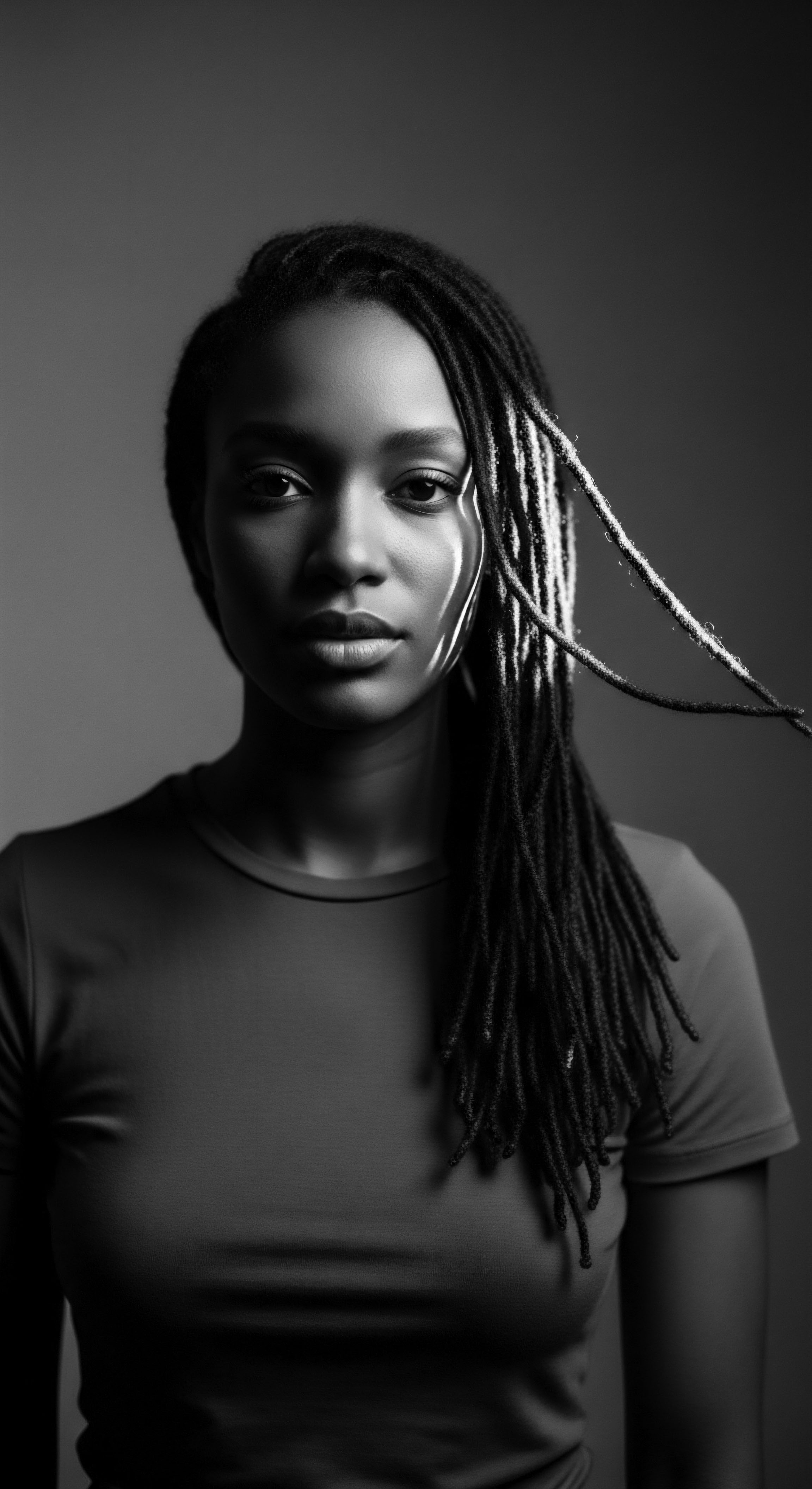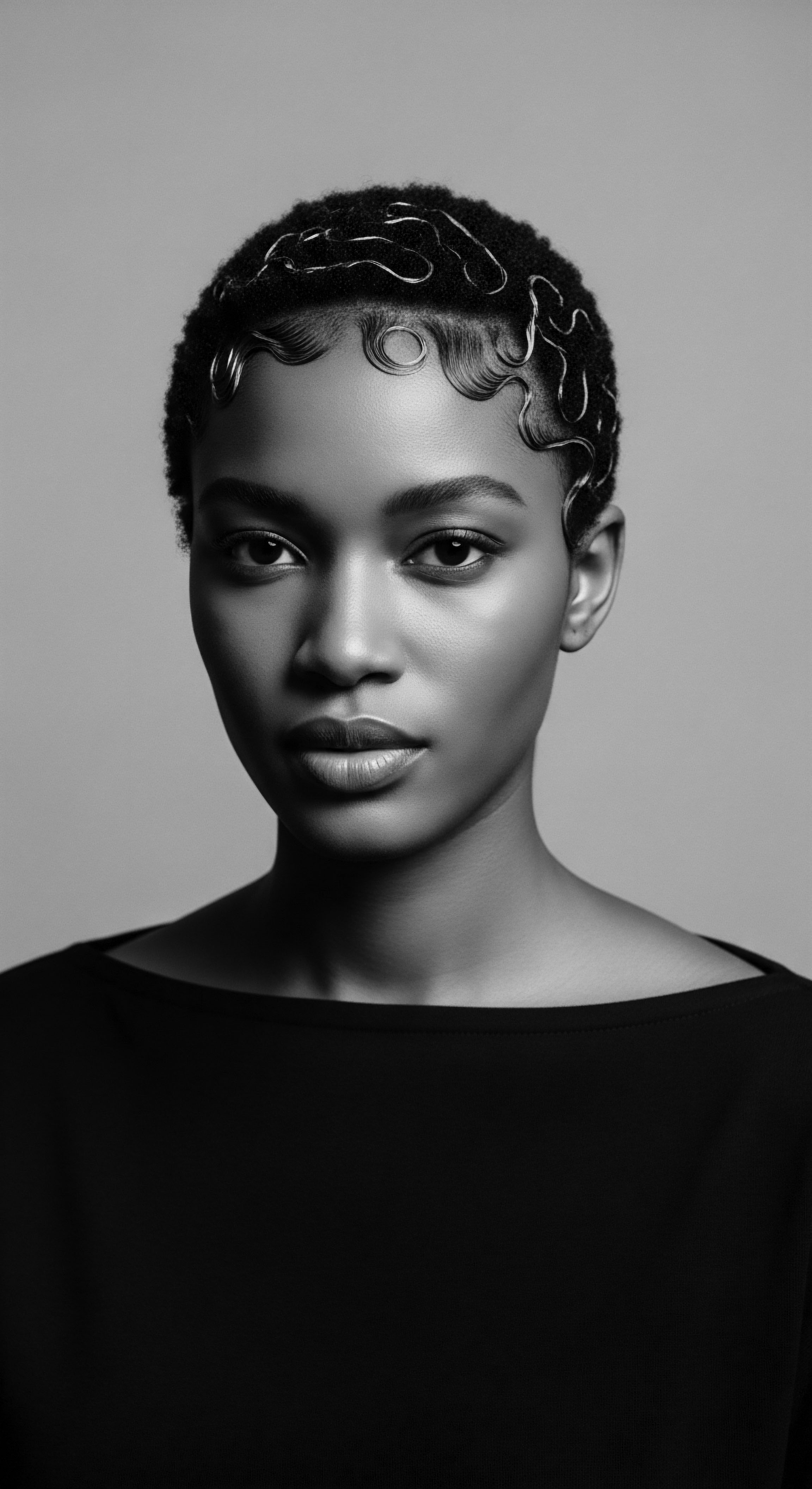
Roots
For those who carry the lineage of textured hair, the very strands descending from the scalp hold stories older than written records, echoing with ancestral wisdom. To truly grasp the enduring spirit of these coils and kinks, particularly when confronting the harrowing period of enslavement, one must first listen to the whispers from the source, recognizing hair not merely as biological fiber but as a living archive of heritage. What was once a symbol of identity, status, and spiritual connection in ancestral lands became, under the brutal weight of bondage, a contested terrain—a site of deliberate desecration and, paradoxically, of steadfast cultural preservation. Understanding this complex inheritance requires delving into the foundational elements of textured hair, its unique biology, and the ways in which its intrinsic qualities shaped experiences during a dark chapter of human history.

How Does Ancestral Biology Inform Hair’s Endurance?
The architecture of textured hair, with its elliptical follicle shape and varied curl patterns, speaks to millennia of adaptation across diverse African climates. Before the forced displacement, these biological attributes were not simply physical traits; they were canvases for social communication, markers of belonging. In numerous pre-colonial African societies, hair styling served as a complex language, conveying a person’s age, marital status, tribal affiliation, wealth, and even their spiritual standing within the community (Johnson & Bankhead, 2014). The very structure of hair, often tightly coiled, provided a natural resilience, a protective quality against the elements, a feature that would later prove both a burden and a blessing during enslavement.
When Africans were forcibly brought across the Atlantic, the first act of dehumanization often involved the shearing of their hair upon arrival. This brutal act, often rationalized by enslavers as a measure for hygiene during the Middle Passage, was in truth a calculated attempt to strip individuals of their former identities, severing their visible ties to their homelands and ancestral customs (Byrd & Tharps, 2001). The intention was clear ❉ to erase the profound meaning embedded in each strand, to dismantle the intricate social fabric hair once represented. Yet, even in this deliberate obliteration, the intrinsic nature of textured hair, its ability to coil and hold, became a silent partner in the survival of cultural memory.
Textured hair, once a vibrant language of identity in ancestral Africa, became a target for erasure during enslavement, yet its inherent qualities held pathways for resilience.

What Was the Original Lexicon of Textured Hair?
The traditional understanding of textured hair transcended mere aesthetic appreciation. It was a knowledge system, passed down through generations, encompassing not only styling techniques but also the botanical wisdom for care. The terms used to describe hair types and styles in various African languages were deeply descriptive, reflecting the diverse curl patterns, densities, and lengths.
These were not rigid classifications meant to rank, but rather observations that guided communal grooming practices and celebrated the diversity of human appearance. The forced removal from ancestral lands meant the loss of direct access to many traditional herbs, oils, and the collective memory of their precise application, forcing those enslaved to improvise with what was available on the plantations.
| Pre-Enslavement Context Identity Marker ❉ Hair styles conveyed tribe, status, age, marital status. |
| Enslavement Era Impact Identity Stripped ❉ Hair often shaved upon capture, a deliberate act of dehumanization. |
| Pre-Enslavement Context Spiritual Connection ❉ Hair considered a conduit to the divine. |
| Enslavement Era Impact Spiritual Disruption ❉ Practices suppressed, yet hidden spiritual meaning persisted. |
| Pre-Enslavement Context Communal Ritual ❉ Hair care was a shared, bonding experience. |
| Enslavement Era Impact Communal Adaptation ❉ Hair care became a covert Sunday gathering, a shared act of defiance. |
| Pre-Enslavement Context Natural Resources ❉ Access to indigenous herbs, butters, and oils. |
| Enslavement Era Impact Resource Scarcity ❉ Forced improvisation with lard, bacon grease, or kerosene. |
| Pre-Enslavement Context The transition from freedom to bondage reshaped the overt expressions of hair heritage, yet its underlying significance remained a wellspring of endurance. |
Despite the harsh realities, the fundamental understanding of hair growth cycles and influencing factors remained. The cycle of growth, rest, and shedding continued, a natural rhythm undisturbed by human cruelty. However, the environmental factors drastically shifted.
The brutal conditions of forced labor, inadequate nutrition, and lack of proper cleansing agents contributed to scalp ailments and hair damage. Still, within these constraints, ancestral knowledge of hair’s fundamental needs—moisture, gentle handling, and protection—persisted, adapted, and was passed down, often in hushed tones, preserving a fragile link to a vibrant past.

Ritual
To truly comprehend the role of textured hair during enslavement, one must look beyond its mere physical presence and consider the profound rituals that continued to shape its existence. Stepping into this space of shared ancestral and contemporary practical knowledge, we witness how techniques and methods for hair care, even under duress, were imbued with gentle guidance and a deep respect for tradition. The styling of hair, once a celebrated art form, transformed into an act of quiet defiance, a silent language spoken through braids and coils, a testament to the enduring spirit of a people. These practices, born of ingenuity and a desperate need for connection, forged a unique chapter in the heritage of textured hair.

How Did Enslaved People Preserve Styling Traditions?
The artistry of textured hair styling, deeply rooted in West African traditions, did not vanish with the transatlantic crossing. Instead, it adapted, becoming a subtle yet powerful means of resistance and identity preservation. Protective styling, a cornerstone of textured hair care today, has its ancestral roots in the very techniques used by enslaved individuals. Styles like cornrows, for instance, were not simply a practical way to manage hair under grueling conditions; they carried coded meanings.
Research indicates that patterns in cornrows could serve as maps to freedom, indicating escape routes, landmarks, or even the number of roads to travel (Thrifts & Tangles, 2021; Odele Beauty, 2024). This ingenious adaptation transformed a beauty ritual into a tool for survival, a testament to the resilience of the human spirit.
The scarcity of tools and products on plantations forced enslaved people to innovate. They crafted combs from discarded materials like wood or bone. Natural styling and definition techniques, honed over generations in Africa, were reimagined with available resources. Substances such as lard, bacon grease, butter, or even kerosene were sometimes used to attempt to condition or straighten hair, though often with detrimental effects.
Despite these limitations, the communal aspect of hair care, a cherished social ritual in Africa, persisted. Sundays, often the only day of rest, became a time for enslaved women to gather, comb, and style each other’s hair, sharing not only practical skills but also stories, solace, and hope. This collective act of grooming became a quiet sanctuary, a space where cultural memory was reinforced and bonds strengthened.
Hair styling during enslavement evolved from an aesthetic practice to a covert language, preserving heritage and aiding survival through ingenious adaptations of traditional methods.

What Was the Role of Headwraps in Hair’s Preservation?
Headwraps, or tignons, played a complex role in the lives of enslaved and free Black women. In some contexts, they were a practical necessity, shielding hair from the harsh sun and dirt of field labor. They also helped retain moisture in hair that lacked proper care. Yet, in other instances, headwraps became a symbol of defiance against oppressive laws.
A notable example is the Tignon Law of 1786 in Louisiana, which mandated that free women of African descent cover their hair to signify their subordinate status to white women and prevent them from appearing “too attractive”. Far from diminishing their presence, these women responded by donning elaborate, colorful, and artfully tied headwraps, transforming an instrument of control into a statement of pride and identity. This act of reclaiming the tignon showcases the profound connection between hair, personal presentation, and resistance to systemic oppression.
The mastery of wigs and hair extensions, while more prevalent in later eras, also has historical roots that touch upon the experiences of enslavement. Some enslaved individuals, particularly those who worked in “house” roles, might have attempted to mimic European hairstyles, sometimes using wigs or shaping their natural hair to appear straighter, a desperate attempt to gain preferential treatment within the brutal hierarchy of the plantation system. This striving for conformity, born of coercion, stands as a stark contrast to the overt acts of cultural preservation, yet both reveal the constant negotiation of identity in the face of immense pressure. The complete textured hair toolkit, in its most rudimentary form during enslavement, consisted of hands, repurposed household items, and the collective memory of a people determined to maintain a semblance of their former lives through the rituals of hair care.
- Cornrow Maps ❉ Intricate braid patterns that concealed escape routes and meeting points for those seeking freedom.
- Seed Carriers ❉ Small grains, like rice or beans, hidden within braided styles to provide sustenance or future crops upon escape.
- Headwrap Statements ❉ Colorful and artfully tied head coverings used to defy oppressive laws and express cultural pride.

Relay
As we ascend to a more sophisticated understanding of textured hair’s place in history, particularly during the era of enslavement, we acknowledge that its role extends beyond mere survival or coded communication. It is a testament to the enduring human spirit, a relay of wisdom across generations, where biological resilience met cultural defiance. The question then becomes ❉ how did the forced circumstances of enslavement not only shape the immediate care practices but also reverberate through time, informing our contemporary understanding of textured hair heritage and its holistic well-being? This segment aims to unravel the deeper scientific, cultural, and psychological layers, drawing connections between historical adaptations and present-day practices, always with a gaze fixed on the profound ancestral wisdom that sustained a people.

How Did Scarce Resources Influence Hair Care Evolution?
The deprivation of traditional African botanicals and tools during enslavement necessitated a stark adaptation in hair care. Stripped of access to indigenous oils, butters, and herbs, enslaved individuals were compelled to utilize whatever was at hand on the plantations. This often meant recourse to substances like animal fats, including lard or bacon grease, or even kerosene, for cleansing and conditioning. While these makeshift remedies were often harsh and damaging, they speak to an unwavering commitment to hair care, a desire to maintain a physical connection to a past where hair was honored.
This period, therefore, represents a critical juncture where ancestral wisdom, though challenged, persisted through improvisation. The knowledge of what hair needed—moisture, protection, and gentle handling—was not lost, but rather translated into new, albeit constrained, forms.
The development of personalized textured hair regimens today, often inspired by ancestral wisdom and validated by modern science, finds its echo in these historical adaptations. The communal grooming sessions, particularly on Sundays, became informal laboratories where techniques were shared and refined, and where the resilience of both hair and spirit was reinforced. This collective memory of care, born of necessity, established a foundation for future generations, underscoring the intrinsic value placed on hair health despite overwhelming adversity. The practices, crude as they might have been, kept the hair from becoming entirely matted or damaged, thereby preserving a semblance of self in a dehumanizing system.
| Historical Context (Enslavement Era) Available Products ❉ Animal fats (lard, bacon grease), kerosene, improvised cleansers. |
| Contemporary Heritage Practices Botanical Riches ❉ Shea butter, coconut oil, argan oil, herbal infusions, specialized cleansers. |
| Historical Context (Enslavement Era) Tools ❉ Handmade combs from wood or bone, fingers, heated implements. |
| Contemporary Heritage Practices Specialized Tools ❉ Wide-tooth combs, detangling brushes, micro-fiber towels, steamers. |
| Historical Context (Enslavement Era) Care Intent ❉ Survival, identity preservation, covert communication. |
| Contemporary Heritage Practices Care Intent ❉ Health, celebration of texture, connection to ancestral practices. |
| Historical Context (Enslavement Era) The enduring spirit of textured hair care, though transformed by circumstance, continues to honor its historical journey from scarcity to abundance. |

What Was the Psychological Impact of Hair’s Denigration?
The systematic denigration of textured hair during enslavement carried a profound psychological weight. European enslavers actively promoted the idea that tightly coiled hair was “woolly” and inferior, a stark contrast to the “good” straight hair of white individuals. This deliberate pathologizing of African hair, often reinforced by preferential treatment given to enslaved people with lighter skin and straighter hair, led to internalized beliefs of ugliness and inferiority within the enslaved community. This caste system, based on hair texture and skin tone, created divisions and perpetuated a damaging self-perception that unfortunately lingered for generations after emancipation.
Yet, even within this oppressive framework, acts of resistance through hair persisted. The choice to maintain traditional styles, however modified, or to adorn headwraps in vibrant, defiant ways, served as a quiet assertion of selfhood. These acts, though seemingly small, were powerful declarations of identity in a system designed to strip away every shred of humanity.
The psychological resilience exhibited by those who continued to honor their hair, despite the immense pressure to conform, underscores the deep-seated connection between textured hair and a sense of self-worth that could not be fully broken. The legacy of this struggle continues to shape contemporary conversations around hair discrimination and the ongoing movement to celebrate natural hair as a symbol of pride and liberation.
- Internalized Bias ❉ The adoption of Eurocentric beauty ideals led to some enslaved individuals perceiving their own hair as inferior.
- Hierarchical Treatment ❉ Lighter skin and straighter hair often granted enslaved people “privileges” like domestic work.
- Resilience in Adornment ❉ Despite oppressive laws, headwraps became statements of beauty and defiance.

How Did Ancestral Wisdom Inform Problem Solving?
The problem-solving approaches to textured hair care during enslavement were deeply rooted in ancestral wisdom, adapted to a brutal new reality. Issues like dryness, breakage, and scalp conditions, exacerbated by harsh living conditions and inadequate nutrition, were addressed with the limited means available. The inherent protective qualities of braided styles, long practiced in Africa, became crucial for managing hair that could not be regularly washed or conditioned. These styles minimized manipulation, retained what little moisture could be found, and shielded the scalp from the elements.
The concept of holistic influences on hair health, a tenet of ancestral wellness philosophies, remained an unspoken guide. Though direct access to healing herbs was scarce, the understanding that overall well-being contributed to hair health likely persisted. The communal aspect of hair care, the shared stories, and the spiritual solace found in those moments of connection, undoubtedly contributed to a collective mental and emotional fortitude that indirectly supported physical health, including that of the hair. This period, therefore, highlights not just the physical adaptations in hair care, but also the enduring psychological and spiritual resilience that allowed a people to maintain their heritage, one strand at a time.

Reflection
The enduring heritage of textured hair, as witnessed through the crucible of enslavement, stands as a living archive of strength, adaptation, and an unbreakable spirit. It is a story not of victimhood, but of profound human ingenuity in the face of unimaginable cruelty. The strands that once held secret maps to freedom, the coils that bore the weight of a forced identity, now speak volumes about resilience and the unwavering commitment to cultural memory. Each twist and turn in the history of textured hair during this era serves as a poignant reminder that true beauty and identity are not defined by external forces, but by the internal resolve to preserve one’s ancestral legacy.
The ‘Soul of a Strand’ ethos finds its deepest resonance in this historical context. It acknowledges that hair is more than keratin; it is a conduit of ancestral wisdom, a repository of collective experiences. The very act of caring for textured hair today, whether through traditional methods or modern innovations, becomes a conscious acknowledgment of this deep past.
It is a way of honoring those who, with limited resources and immense courage, maintained their hair not just for survival, but as a silent declaration of their enduring humanity. The journey of textured hair through enslavement is a powerful testament to the enduring power of heritage, a beacon guiding us towards a future where every strand is celebrated for its unique story and its place in the grand continuum of human experience.

References
- Byrd, A. D. & Tharps, L. L. (2001). Hair Story ❉ Untangling the Roots of Black Hair in America. St. Martin’s Griffin.
- Johnson, A. & Bankhead, C. (2014). The importance of hair in the identity of Black people. Nouvelles pratiques sociales, 26(2), 29-43.
- Nabugodi, M. (2021). Afro hair in the time of slavery. The Gale Review.
- Odele Beauty. (2024). A History Lesson On Hair Braiding.
- Thrifts & Tangles. (2021). The Evolution of Black Hair for Beauty & Resistance.
